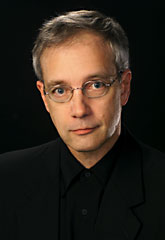|

David Gompper, by CARSON P COOMAN
Composer Profiles is a periodic article series focusing on composers of classical concert music from around the world who are consistently writing works of the highest artistic quality -- music that deserves to be more widely known. Each article will provide a brief biographical profile of each composer and listening examples with integrated audio excerpts.
The first composer to be profiled is David Gompper, an American composer born in 1954. Educated at the Royal College of Music in London and the University of Michigan, Gompper has been based since 1991 in America's heartland, where he has been a professor of music at the University of Iowa in Iowa City; he also serves as director of the university's prestigious Center for New Music. Started over forty years ago by Gompper's predecessor, longtime professor and distinguished composer Richard Hervig, the CNM is one of America's most active centers for the promotion of contemporary music. Gompper has continued its tradition of concerts, tours, recordings, and guest artists.

David Gompper
|
David Gompper's catalogue of music encompasses works in all genres except opera, although his first opera is a forthcoming project for 2010. Though he has written for orchestra and wind ensemble, the vast majority of his compositions are chamber works, ranging from pieces for 'typical' combinations (eg violin and piano) to more unusual groupings (such as bassoon, flute, piano, and percussion). Vocal works also figure strongly in his output, particularly settings of texts by the American poet Marvin Bell, a fellow Iowa-based creative artist. His most recent composition for solo voice is a moving setting for baritone and piano entitled Mrs Bixby's Sons (2004), taking as its text the famed letter of condolence attributed to President Abraham Lincoln. Gompper creates a song of deep emotion, as the simple lyricism of the beginning grows to a climax of searing intensity.
Listen -- opening of Mrs Bixby's Sons
© 2004 David Gompper
For this listener, the most notable characteristic of Gompper's music is the deeply organic way he integrates simple material and its complex elaboration and development. Although this dichotomy is clearly part of the process of many composers, few are as skilled as Gompper at consistently creating a single, inevitable musical arc. Every composer faces the challenge of devising a way by which to construct a piece from its basic material -- straddling the line between 'clever-seeming' development processes that are too arcane for audibility and overly pedestrian techniques that provide no intellectual engagement. Gompper has a singular gift for creating developmental processes that are satisfyingly inevitable to a first-time listener, yet sophisticated enough to provide continued enjoyment through ongoing familiarity with the music. Thus, Gompper's music never feels as though disparate elements are simply juxtaposed together. Rather, his pieces (most all of which are structured in a single, unfolding movement) have an inevitability to them that, at every point of the musical process, convinces the listener that everything is exactly as it should be.
A number of of Gompper's works take their point of departure from existing music of other composers. His Three Irish Fiddle Tunes will be discussed later and is a strong recent example from his catalogue. Musica Segreta (1996, revised 2006) for piano quartet draws its musical material from an intersection of quotations/pitches from the music of Boulez, Stravinsky, and Gesualdo.
Listen -- middle of Musica Segreta
© 2006 David Gompper
Butterfly Dance (2001) for clarinet, violin, viola, cello, and piano uses a dance of the Native American Hopi tribe as its source material.
Listen -- end of Butterfly Dance
© 2001 David Gompper
In these cases (and others), it is clear within moments that the source material is not simply a 'hook' or grafted into an existing process. Rather, Gompper looks to provide new musical perspectives of his source material at very point.
In other cases in Gompper's output, his processes unfold entirely from his own musical material, such as a fun piece for thirteen string players entitled Flip (1993). The work starts from the basic ideas of differing string timbres, playing techniques, and textures; throughout its duration, Gompper plays them off each other in an acrobatic dance of textural color.
Listen -- opening of Flip
© 1993 David Gompper
For a number of years, Gompper has performed as a pianist with Austrian violinist Wolfgang Dávid. The Gompper-Dávid duo has given concerts around the world, commissioned numerous new works for violin and piano, and recorded two CDs. For the 2008-09 concert season, Gompper has composed a violin concerto for Dávid and the Royal Philharmonic of London. Gompper has written a number of recent chamber works for Dávid, including a remarkable triptych entitled Three Irish Fiddle Tunes. The three works within this cycle -- Star of the County Down (2005), Music in the Glen (2004), and Finnegan's Wake (1997) -- each provide an excellent demonstration of Gompper's transformative art. The Irish source material is integrated into sophisticated concert pieces. Though there is a great deal of concert violin music connected to 'fiddle traditions' (particularly given the popularity of folk fiddler recordings in recent years), Gompper's work is a strong example of how a composer's own musical voice can say something very compelling about familiar material. The results are exhilarating.
Listen -- Star of the County Down
© 2005 David Gompper
David Gompper's website can be visited at www.davidgompper.com. There you will find further information about his career and music, and also full audio recordings of nearly all of his compositions, including the works specifically mentioned in this profile. Commercial recordings of several works are also available on the Albany label.
Gompper's catalogue is full of delights for performers and listeners alike. The tremendous musicality of his compositional voice compels immediately, the fertility of his imagination keeps one waiting for what will happen next, and his ear for textures and harmony creates consistently engaging sonic landscapes.
Copyright © 26 August 2008
Carson P Cooman, Massachusetts USA

|

